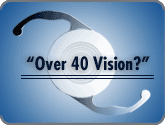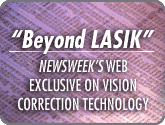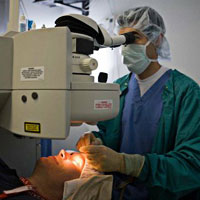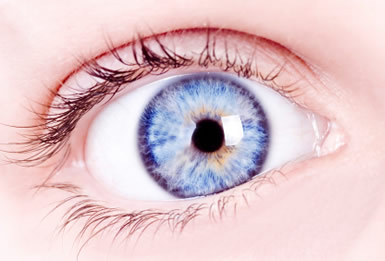MAP & LOCATION
Boothe Eye Care & Laser Center
3900 West 15th Street
Suite 104
Plano, Texas 75075
(214) 328-0444
Google Map
NEWS & UPDATES

Consumers agree, Boothe Eye Care & Laser Center is the best provider of Lasik and IntraLASIK in the Dallas Fort Worth area.
Nominate Dr. Boothe for 2009
 AcrySof Restor
AcrySof Restor
Experience a full range of vision without reading glasses or bifocals.
Learn More About Restor
 “Beyond LASIK”
“Beyond LASIK”
Read Newsweek’s web exclusive on the latest technologies available
for vision correction.
Click For More
Nearsightedness, known scientifically as myopia, means that a person sees nearby objects more clearly than distant objects. It does not mean that a myopic person has excellent near vision and poor distance vision. Extremely nearsighted people do not see anything clearly. In the normal eye, parallel rays of light passing through the cornea bend slightly and then bend again as they penetrate the lens to focus on a small, single spot on the retina. In the nearsighted eye, a steeply curved cornea or an elongated eyeball, or both, focus rays of light before they reach the retina. From this focal point the light rays begin to diverge. By the time light reaches the retina, the image is blurred.
Farsightedness, known as hyperopia, is the opposite of myopia. It is not necessarily the ability to see objects clearly at a distance and poorly close up, although this can be the case. In the farsighted eye, rays of light streaming through the cornea and lens reach the retina before they come into focus, creating a blurred image. In a sense, the eyeball is too short for the refractive power of its own optical system. Sometimes, mildly farsighted people do not discover this refractive error until middle age, when they begin to have trouble seeing clearly at close distances. This explains the common need for reading eyeglasses among our middle-aged population.
An astigmatic eye results from an imperfectly shaped cornea. The cornea of the astigmatic eye might be poorly curved from top to bottom or from side to side. This error of design gives the cornea different refractory powers across its length and width and distorts sight. Some light rays focus in front of the retina and others, behind it. As a result, the retina never receives a single, sharp image.
Presbyopia is an optical flaw that eventually affects almost everyone. As the eyes age, their powers of accommodation decline. It becomes increasingly difficult for the eye to bring nearby objects into focus. An individual with presbyopia can also be farsighted, nearsighted, or astigmatic at the same time. If this is the case, bifocals can give the eyes extra help with nearby objects, no matter what other refractive errors the eyes may have.
Everyone’s focusing ability is different. Most people will be able to see clearly at all distances, however, some people may be more comfortable with additional correction, particularly at night or in dim light. It is important to remember that implant surgery cannot resolve pre-existing visual conditions such as floaters, flashes, or visual field loss that are a result of conditions of the eye and not related to the lens. Dr. Boothe will thoroughly discuss the restoration of your vision, recommending a specific plan for optimizing your uncorrected vision.
While most patients experience much improved vision after cataract surgery, some will have better uncorrected vision than others. It may be necessary for some people to wear glasses for distance and/or near vision to obtain optimal visual acuity. The difference from standard lenses is that most crystalens patients will not be dependent on these supplemental vision aids to function normally.
Insurance coverage varies greatly depending on the policy and provider. Generally speaking, private insurance may cover the cataract surgical procedure and anesthesia. It may also allow a certain additional amount for the artificial lens implant. The insured is then required to pay a deductible as well as any additional amount above the primary coverage. (Some patients are responsible for the total payment - not all insurance companies will cover some.)
Your surgical counselor will review your insurance coverage and your surgical alternatives prior to the crystalens procedure. It may also be beneficial for you to contact your insurance carrier.
The Verisyse Phakic Intraocular Lens (IOL) implant is recommended for patients who do not qualify for LASIK due to severe nearsightedness, farsightedness, or cases where the cornea is too thin for LASIK. For patients who undergo the Verisyse Phakic Intraocular Lens replacement implant procedure, the natural lens is left in place to retain the lens’ natural ability to read up close and adjust for objects farther away. In the past, before the Verisyse Phakic Intraocular Lens, many patients lost their ability to read up close and adjust for objects farther away without wearing corrective eyewear after lens replacement implant surgery.
LASIK Web Marketing Powered by Ceatus Media Group LLC

